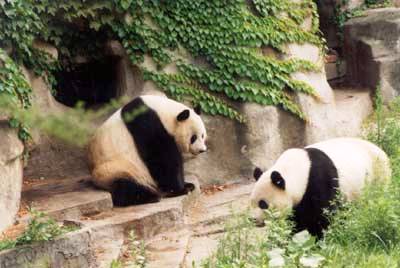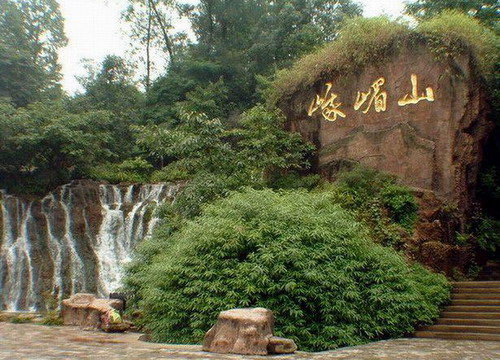Hailuogou Glacier Park

Hailuogou (Conch Gully) National Glacier Forest Park is located on the eastern side of Gonggar Mountain in Luding County of Tibetan Autonomous Prefecture of Garze, Sichuan Province. It is 319 km from Chengdu, the capital city of Sichuan Province and 105 km from Kangding, where administrative organs of the Garze Autonomous Prefecture are located. Glaciers in Hailuogou are typical modern marine glaciers, which are rarely found either in low-latitude places or at low altitude. Hailuogou is 3,200-4,800 meters above sea level. Its lowest point is only 2,850 meters above sea level. Its average temperature in summer is 25 ° C.
The park boasts many geographic attractions, including ancient glaciers, grand glacier cascade, virgin forests, wild animals and hot springs, etc.
Glaciers
Glaciers cover 31 square kilometers of the Conch Gully. Classified as Modern Glacier, they came into being 16 million years ago. The Grand Glacier Cascade -- 1,000 meters in height and 1,000 meters in width -- is the only one in the world. Its 6 km glacier tongue penetrates into the virgin forest, forming a rare natural landscape with the blend of glacier and forest.
Grand Glacier Cascade
The Grand Glacier Cascade, with a drop of 1,080 meters, is made up of numerous ice cubes. Looking like the milk way descending from heaven, it sends out brilliant rays in the sunshine.
Beyond the cascade there is a snow basin -- the source of the glacier. When the frozen water accumulates to a certain amount and the surplus ice and snow need to find a way out, there will be an avalanche. So, for safety's case, the snow basin can only be seen from afar, which is a pity for such a unique attraction. Moreover, the glacier fall may collapse at any time, too. During spring and summer, the dynamic seasons for glaciers, over 1,000 avalanches may happen in a day. In one such collapse, the falling ice can reach 1 million cubic meters. As electricity is produced during the hit and friction, blue sparks are sent out together with earth-shaking roaring.
Since the vista is several kilometers from the Grand Glacier Cascade, tourists do not need to worry about harms from even the biggest avalanche.
Hot Springs
Another special attraction of the Conch Gully is its hot springs hidden either in virgin forests or under the cover of snow and ice. The most noted ones are  at No.1 and No. 2 campsites.
at No.1 and No. 2 campsites.
In No.2 Campsite, hot springs gush out from rock cracks year round, with a daily flow of 8,900 tons. Water temperature at the mouth can reach as high as 90 ° C. The hot springs gush into a small pond, from where they drop down along a cliff to form a waterfall of eight meters wide and 10 meters high. The spring water is believed to be effective in curing diabetes, neuralgia, arthritis and gastroenteritis. Nearby, a swimming pool has been built in the open air for tourists' convenience.
There are also a big swimming pool and small-scale bathrooms in No.1 Campsite. The famous Gonggar Miraculous Fount is located at 1,600 meters above sea level, where travelers don't need to worry about altitude sickness. Still, most of the visitors favor hot springs in No.2 Campsite because they are rustic, with more natural taste.
Recommend you to stay overnight at Camp No. 2 which sits at 2620 m, you might dip into the hot springs when it is snowing outside the window.
Forests
Hailuogou was originally the valley of an ice-melted river on the eastern side of the Gonggar Mountain. With an elevation of 6,000 meters, it has seven climate zones and its vegetation varies at different levels of height, making it a rare natural botanic garden.
Virgin forests can be seen not far from the No.2 Campsite. Covering an area of 70 square km, the forests boast 4,800 species of plant, including fir, wild sweet-scented osmanthu, wild rhododendron, ginkgo, algum, magnolia, single-leafed grass, and such medicinal herbs as Chinese caterpillar fungus, caladium, pseudo-ginseng and tuber of elevated gastrodis.
Lake
Going up from the hot springs, tourists can find an ice lake, called S huihaizi , or Water Sea. It looks like a gem imbedded in a wood of Chinese yew ( Taxus chinensis ), katsura tree ( Cercidiphyllum japonicum ), Kangding magnolia and big-leafed azalea. In sunny days, the snow mountain, green trees and blue sky all have their reflections in the lake, creating a dreamland.
The legendary place is also home to over 400 kinds of wild animals, including 28 endangered species under state protection. While roaming through the area, tourists may luckily encounter animals such as blue sheep, macaques, or even pandas and sunbirds.






